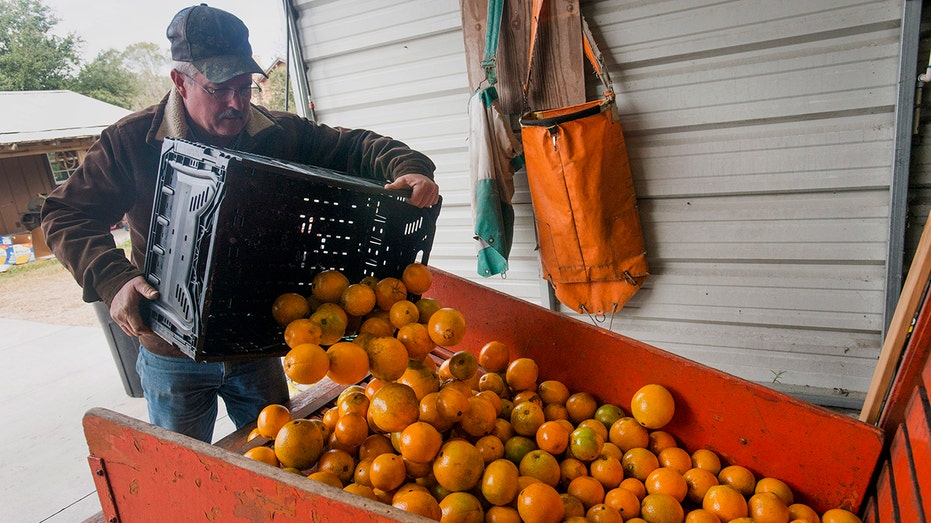Orange juice prices likely to stay strong, expert says
USDA predicted that production for Florida oranges in 2022-2023 season will be down 56%
Hurricane Ian's impact on the citrus industry
Everstream Analytics Chief Meteorologist Jon Davis discusses Hurricane Ian's effect on the citrus farming industry on 'Mornings with Maria.'
The Florida orange crop, which has been "dealt a heavy blow," is now the smallest it's been since the 1930s, according to commodities analyst Judy Ganes.
Consumers will feel the effects at the grocery store when buying orange juice.
Retail prices for orange juice have continued to surge because of late a freeze last year that harmed the buds for the crop, Hurricane Ian and a proliferation of the citrus greening disease that has been harming productivity for nearly two decades, Ganes, who is also the founder of J Ganes Consulting LLC, told FOX Business. Prices are likely to remain strong as well, she added.
The U.S. Department of Agriculture even predicted another hard year for Florida oranges. The agency forecasted production for the 2022-2023 season to be at 18 million boxes, which is down 56% from last season's final production.
FLORIDA ORANGE PRODUCTION DOWN 32% FROM LAST SEASON, USDA SAYS

The Florida orange crop, which has been "dealt a heavy blow," is now the smallest it's been since the 1930s, according to commodities analyst Judy Ganes. (Ty Wright / Bloomberg via Getty Images / File / Getty Images)
A spokesperson for the USDA told FOX Business that the crop in Florida this year is smaller than California for the first time in decades due to the weather conditions and hurricanes.
"The industry is really, really struggling hard to keep orange juice on the table," Ganes said.
The Wall Street Journal reported that prices for a gallon of orange juice in some areas is already above $6.
PRICE OF ORANGE JUICE ON THE RISE AMID FORECASTS OF SMALLEST CROP SINCE 1945
According to the USDA, citrus greening is one of the "most serious citrus plant diseases in the world." When trees are infected with this incurable disease, citrus will drop from the tree before they are fully ripe because the tree is too weak to sustain them.
Most trees will also die within a few years of being infected, according to the USDA.

A spokesperson for the USDA told FOX Business that the crop in Florida this year is smaller than California for the first time in decades due to the weather conditions and hurricanes. (Ty Wright / Bloomberg via Getty Images / File / Getty Images)
The problem dates back to the early 2000s when a handful of hurricanes hitting Florida proliferated the spread of the disease, according to Ganes.
"The fruit starts to develop, and then to the horror of the growers, it winds up on the ground…50% of the fruit falls to the floor," she said.
HURRICANE IAN RECOVERY: OVER 435K FLORIDA CUSTOMERS STILL WITHOUT POWER
On top of that, the size of the fruit on the trees are much smaller.
"The yields are not what they were before," which means the processors have to buy more fruit to get the same quantity of juice, according to Ganes.

According to the USDA, citrus greening is one of the "most serious citrus plant diseases in the world." (Ty Wright / Bloomberg via Getty Images / File / Getty Images)
This year is particularly challenging because there was of the freeze last January that hurt the buds of the fruit that's now being harvested, she said.
GET FOX BUSINESS ON THE GO BY CLICKING HERE
Then Hurricane Ian, which touched down in southwest Florida in September as a Category 4 storm, exacerbated the situation. The storm, which brought with it winds estimated at 155 mph, blew more fruit off the already dying trees.
An upcoming report from the University of Florida-Institute of Food and Agricultural Sciences is slated to estimate that Hurricane Ian caused more than $1 billion worth of damage to Florida's agriculture industry, including $247 million in citrus damages.
That figure is the estimated value of fruit loss and does not including repair or replacement costs of damaged or destroyed citrus trees or infrastructure.





















